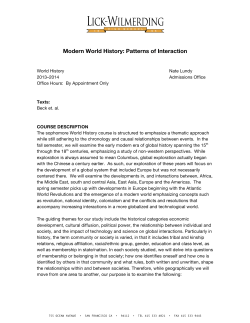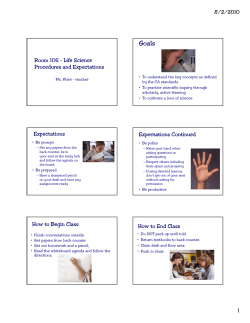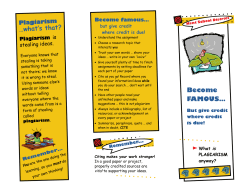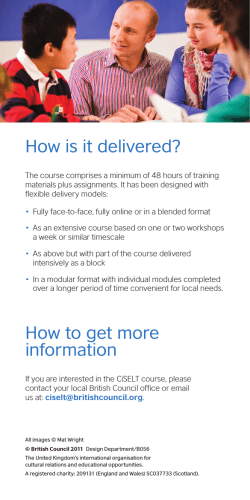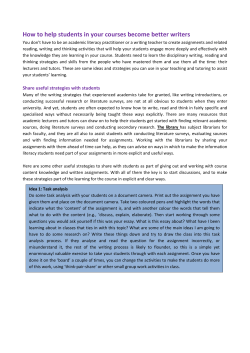
Propaganda & Media
COMM549: Propaganda and Media Prof. Simpson Fall 2009 Wednesdays, 2:10 to 4:50 PM Propaganda & Media This is a study of propaganda systems, not a ‘how-to’ course. We examine key institutions, techniques, and objectives of domestic and international propaganda. We’ll discuss definitions, theory, research methods, origins and history of propaganda, common misunderstandings, propaganda and violence, psychological warfare and covert operations, information operations, public diplomacy, and emerging technologies. Goals • To significantly strengthen your ability to identify, understand, and analyze both domestic and international propaganda operations; • Introduce you to the role of communication research and sociological theory in understanding propaganda and media; • Help you to better understand the web of interdependencies among propaganda operations, conventional media organizations, and violence perpetrated by state or non-state actors; • Review emerging social media and Web 2.0 propaganda and information operations; and • Guide you through the creation of an in-depth case study of a current institution or controversy in propaganda and media. 1 In particular, the course will cover the following topics, in roughly this order: Definitions, oversimplifications, overview Goebbels’ model: Propaganda viewed as technique or science Propaganda viewed as ‘persuasion’ or ‘democracy in action’ Emerging Web 2.0 propaganda operations Chomsky and Herman’s model: Propaganda as social structure Propaganda and ritual: communication, teaching, power, culture Propaganda and intelligence gathering Propaganda of the deed: psychological operations; terror; insurgency; counterinsurgency Propaganda and structural violence Office Hours My office is at 330-H Mary Graydon Center and my office hours are noon to 3 PM on Mondays and Thursdays. I’ll meet with you ‘first come – first served’, or you may sign up for an appointment at a specific time. My telephone number at work is 202 885-2037 and my e-mail is simpson@american.edu. My mailbox is at MGC 300, or you may slip papers under my office door. Books and Supplies This is a graduate course. It will require a good deal of reading and writing. In order to make the course as current and relevant as possible, course study materials are drawn from the WWW or posted on Blackboard. Required readings are listed in the course schedule. Keep in mind that course reading assignments may change depending on unfolding events. At this time, there is no required textbook. This approach is designed to save you money and make study more convenient. But it also requires of you a greater degree of self-discipline and attention to the subject. Please be sure to speak with me during class or office hours if you have difficulty locating or understanding course readings. 2 Grading Policy The grade of A is awarded only for excellence. Students who achieve an A have turned in all work on time; consistently demonstrated creativity, originality and high quality in their work; and earned an A on course projects and examinations. The grade of B is given to students who have turned in all work on time; whose work shows creative thinking, extra effort or care in presentation; and who have achieved a B average on class projects and examinations. The grade of C is given to students who have turned in all class work; maintained an average of C grades on class projects and examinations (as proportioned below); and when the overall evidence indicates that the student has mastered the basic materials and skills of the course. Students who earn 70 or more points toward their final course grade receive a ‘C’ in this course. The grade of D or F is given for work that is below standard, incomplete, or consistently late; to students who have achieved a D or F average on class projects and examinations; to students who fail to attend three or more class sessions (except for authorized absences), or when the overall evidence indicates that the student has not mastered the basic materials and skills of the course. Violations of the university's Academic Integrity Code may also result in an F grade. Calculating the Course Grade The course grade is calculated as follows. These assignments and how they are scored are explained in more detail below. Class Prep and Course Contribution . . . . . . . . 30 points Midterm Exam and Progress Report . . . . . . . . 20 Term Project . . . . . . . . . . . . . . . . . . . . . . . . . . . 30 Final Exam. . . . . . . . . . . . . . . . . . . . . . . . . . . . 20 ====== 100 points 3 The relationship between letter grades and the number of points awarded on assignments is explained next. Letter Grades Letter grades for the course are assigned like this: 100 -- 95 points = A 94 --- 90 points = A85 --- 89 points = B+ 80 --- 84 points = B 79 --- 77 points = B76 --- 73 points = C+ 72 --- 70 points = C 69 --- 60 points = D Class Preparation and Course Contribution This is a seminar course, so your class preparation and course contribution play an important role in what you get from the course and in your course grade. During ten of our 14 class sessions, each student will earn from zero to three points for the CP&CC assignment due that day. Details of these assignments are listed in the course schedule. In general, though, you’ll prepare a concise 1 to 2 page Commentary on the assigned course readings and current events relevant to the course. These will become part of that session’s class discussions. Your goal in these commentaries is to demonstrate an increasingly detailed and sophisticated understanding as we go forward of the propaganda and media issues we are examining in this course. The points are for completed homework posted to the course Discussion Boards, constructive participation in class sessions, and other course contributions. I’ll explain discussion board postings in more detail in class. CP&CC 4 is an opportunity for you to earn credit for the efforts you have made to help make this class interesting and useful for other students. Together, the CP&CC scores count for up to 30 points toward your course grade. Week-to-week credits for CP&CC are assigned like this: 3 . . . . . . very good, outstanding 2 . . . . . OK, good 1 . . . . . below standard; needs quick improvement 0 . . . . . no credit Other factors considered in the CP&CC score are your contributions to class discussions; other contributions such as sharing articles, news, useful websites, etc.; and in-class assignments. I’ll provide feedback on your CP&CC scores. The section of the syllabus titled 16 Ways to Improve Your Course Contribution (below) provides further details and ideas on how to strengthen your scores in this area. Please keep two things in mind about these scores. The first is that I am only able to score what a person demonstrates to the class, not what is in that person’s mind or what he /she would like to do. It is up to you to find a way to make your contributions clear to everyone. Second, the score of four for a class session is an ‘A’ score and is awarded only for excellence. Showing up and completing all CP&CC assignments satisfactorily is great and will probably ensure that you do well in this part of your course grade. But showing up and doing satisfactory work by itself does not earn an ‘A’. Midterm Exam and Progress Report The Midterm Exam will take place Wednesday, October 8. This has two parts. The first is an in-class Midterm Exam, and the second is a written report on your progress on your Term Project. Together these count for up to 20 points toward your course grade. 5 Please check under ‘Term Project’ (next) for a discussion of your Mid-Term Progress Report. Term Project Your term project is a 16 to 20 page academic paper on an important current issue in propaganda and media, or an in-depth profile of a major propaganda organization or campaign. This assignment counts for up to 30 points toward your course grade. You are welcome to propose Term Project subjects during the first weeks of class. These must be approved in advance by the professor. Those who do not propose a ‘do-able’ topic will be assigned A TOPIC during our third course session on Sept. 9. The completed paper is due on Monday, Nov. 23 – before the Thanksgiving break. Research for your term project should locate at least three primary source documents (or other records, such as recordings), and at least four scholarly or academic sources, such as relevant articles from peer-reviewed journals. These are in addition to relevant news clippings or other general media sources. The paper should be double-spaced and use conventional margins. Spelling, grammar and composition will count during evaluation of the paper. Plagiarism is prohibited, of course. All direct quotations must appear within quote marks and be clearly attributed to their source. Paraphrased materials must be clearly attributed. See the section of the syllabus titled Footnoting Policy, below, for additional information. Many students find it useful to consult American University’s Writing Center for assistance with writing questions. You may also present your project using a medium and format other than an academic essay, such as in a webpage construction, streaming video or in other web-based, interactive formats. Projects using other mediums or formats must be approved in advance by the professor and require a level of research and expression comparable to that of a 16 page academic essay. 6 Term Project format: Please use the following format for your Term Project. This format will simplify writing your report and make it easier for you to do a thorough job. It also helps ensure that grading is done fairly. 1. 2. 3. 4. 5. 6. Introduction, including a short summary of the paper as a whole; Identify and discuss the key issues you will consider in your paper; The history of the controversy, institution or operation, including the who, what, when, where, how, and why of your topic; Examples of how key developments or innovations played a role in your topic; A conclusion that summarizes the most important points discussed in your paper; and Bibliography for your paper. (Bibliography is not included in Term Project page count.) Photocopied Appendixes to your paper: Your paper must include three appendixes. These are not included in the page count for your paper. Appendixes A. A copy of all materials that you have quoted or paraphrased in your paper. The quoted or paraphrased portions must be clearly marked with a highlighter or other clear notation. Please do not neglect this requirement. B. Copies of at least three key examples of the media product, archival record of the institution, or other documentation central to your study. This can be provided on paper or as a digital recording of audio or visual materials; and C. Annotated URLs for at least six specific web pages that feature information relevant to understanding the topic of your term project. These URLs could include websites managed by a key organization involved in a propaganda operation or controversy, for example, pages relevant to the history of the topic, pages concerning communication theories or analysis you have employed, and so on. Make sure the URLs 7 are accurate. A single-page summary is enough for this appendix – you need not provide copies of the websites. Midterm Progress Report on Term Project: You’ll prepare a Midterm Report on your progress on the Term Project. This is one half of your score on your Midterm Exam. Here is what to include in your Midterm Progress Report: o A draft of a 80-word Abstract (summary) of the report as a whole; o Six (or more) pages of an advanced draft of the text of your final project (footnotes are required for quotations and/or paraphrases); o Photocopies or printouts of at least four (out of the required seven) of your primary source materials and/or scholarly sources used for the Term Project; o A list of least four websites that include materials that are particularly relevant to your project, along with a short discussion of the materials you have found on those sites. The basic factors used to evaluate the ‘Midterm Progress Report’ part of your Midterm Exam will be the same ones that will later be used to evaluate the Term Project itself. However, I’ll adjust them to take into account this is an interim report, not the final project. Evaluation of the Term Project: Your final term project will be evaluated on: • Whether you have completed the basic assignment, meaning whether the essay is 16 to 20 pages long, footnoted, with the required appendixes, etc.; • The depth, quality and sophistication of your research, including your ability to evaluate the reliability of your source materials and to handle arguments from conflicting sources; • The clarity and coherence of your analysis presented in the paper, particularly the quality of your reasoning and use of evidence; • Creativity and originality; • The effectiveness of your presentation, including spelling, grammar and composition. Use of appropriate charts, graphics or audio information definitely counts in your favor, but they are not part of your page count; 8 • Any added value you contribute that goes beyond the basic assignment, such as inclusion of additional appendixes of resource materials, web lists, annotated source lists, contact information or similar enhancements. Policy on Footnoting: This is a tedious topic, but it always comes up, so here is information about footnoting. You must footnote your Term Project and all essays you write for this course. MLA footnoting style is the standard used at AU, so we’ll use it in this course as well. That’s the one that looks like this (Smith 2007: 15). Remember that each citation has to be accompanied by a bibliographic entry that looks something like this: Smith, John S. (2007). Footnote Frenzy, Or, Why College Writing Makes a Difference. New York: XYZ Publishing. As you learned in your freshman College English course, all quotations and significant paraphrasing has to be footnoted. Please check American University Library’s online information literacy tutorial for information on footnoting techniques and practices (section five of the tutorial). The tutorial also includes very good self-teaching information on how to find and evaluate research materials (Aladin, online databases, periodicals, etc.) how to cite them, how to avoid plagiarism and other relevant topics. http://www.library.american.edu/tutorial/index.html Final Exam There will be a routine Final Exam for this course during exam week. This counts for up to 20 points toward your course grade. I’ll announce the time and place for the exam as soon as that information becomes available from the Provost. Extra Credit You have the option of earning up to ten points in extra credit toward your course grade, in addition to points earned through the required assignments. Many students find this to be an effective way to strengthen their final course grade. 9 The number of points earned for extra credit projects depends on the amount and quality of the work involved. For example, a short powerpoint presentation on a subject relevant to the class might earn five points, for example. A longer or more complex research project could earn up to ten points. Students may do several extra credit projects up to a maximum of ten points. I especially value extra credit projects that are likely to make an ongoing contribution to future sections of this course. Extra credit projects must be approved in advance and delivered before the last day of class. No extra credit or make-up work is available once the course has been completed. Contact me for details. Spelling, Grammar and Writing Unless I ask you otherwise, all written class assignments should be typed, double spaced, with conventional margins. Spelling, grammar and quality of writing do count. Attendance and Deadlines University policy requires you to attend each class session unless you have an excused absence authorized by the professor. Please show respect for your colleagues by arriving on time. Three or more unexcused absences put you in considerable danger of failing this course. Weekend road trips or visits with out-oftown friends are not excused absences. Work missed due to an excused absence may be made up. The grades on any assignment missed due to an unexcused absence, on the other hand, will be marked down quite a bit. This ensures fair treatment for students who make the sacrifices necessary to turn in their assignments on time. Because deadlines are so important in all aspects of media and communication, any assignment that is not turned in on time will be marked down for each day it is late. 10 Bona fide religious holidays are excused absences. Because the dates for religious holidays are known well in advance, persons who wish to observe them must turn in their homework or other regular assignments on time in order to receive full credit. Classroom work missed due to a religious holiday can be made up like other excused absences. Please contact the professor if you have questions about how this policy applies to you. If you miss a class session, it is up to you to contact me within one week for the assignments. Academic Integrity The university's provost has asked that the following notice be included in all course syllabi: "Standards of academic conduct are set forth in the University's Academic Integrity Code. By registering, you have acknowledged your awareness of the Academic Integrity Code, and you are obliged to become familiar with your rights and responsibilities as defined by the Code. Violations of the Academic Integrity Code will not be treated lightly, and disciplinary action will be taken should such violations occur. Please see me if you have any questions about the academic violations described in the Code in general or as they relate to particular requirements for this course." Plagiarism Plagiarizing other people's work is a very serious violation of AU’s Academic Integrity Code that could result in your expulsion from the university. The dictionary definition of plagiarism is: "to present the words or ideas of another as one's own" (New Merriam-Webster Dictionary, 1989). Here are examples of plagiarism: In an essay concerning sweatshop labor in Pakistan, a student wrote: No two negotiations for the sale of a child are alike, but all are founded on the pretense that the parties involved have the best interests of the child at heart. [....] On a very hot 11 morning in the Punjab village of Wasan Pura, a carpet master, Sadique, describes to a brick worker named Mizra, the advantages his son will enjoy as an apprentice weaver. "Nadeem is bright and ambitious...." (etc.) The true author, Jonathan Silvers, had written in Atlantic Monthly: No two negotiations for the sale of a child are alike, but all are founded on the pretense that the parties involved have the best interests of the child at heart. [....] On this sweltering morning in the Punjab village of Wasan Pura, a carpet master, Sadique, is describing for a thirtyyear-old brick worker named Mizra the advantages his son will enjoy as an apprentice weaver. "I've admired your boy for several months," Sadique says. "Nadeem is bright and ambitious...." (etc.) Later in the same essay, the student wrote: In Pakistan, a soccer ball cost 200 rupees. With profit thrown in and including labor and materials that's about six dollars. In the U.S. these balls sell for thirty to fifty dollars. [.....] The words Hand Made are clearly printed on every ball; not printed is any explanation of whose hands made them.... (etc.) The true author, Sydney H. Schanberg, had written in Life magazine: I tell Afzal Butt... I need one of the Nike [soccer] balls for my engineers to test. No problem, he says, selling me one for 200 rupees (roughly $6). That's what it costs to make a quality soccer ball in Pakistan, in labor and materials, with profit thrown in -- just $6. In the U.S. these balls sell for $30 to $50. [...] The words Hand Made are printed clearly on every ball; not printed is any explanation of whose hands made them.... (etc.) Talk to me if you have questions or concerns about plagiarism. Please note that copying another student's work is also plagiarism, just as copying published work is. Purchasing a paper written by someone else and turning it in as your own work is a major mistake. 12 16 Ways to Improve Your Course Contribution Your class preparation and course contribution counts for 30 percent of the course grade in COMM 549. This rewards students who make outstanding contributions to other people's understanding and enjoyment of the course. Students who become involved in the intellectual life of the course learn more and have more fun as they learn. 1. Above all, help others to participate fully in the life of the course. For some people, this will mean speaking out more frequently, while for others it may mean holding back to give another person a chance to speak. 2. Work with your colleagues in research or to share resources. While everybody's writing and analysis must be their own, it is fine to critique drafts of one another's papers and to offer suggestions for improvements. (If you have questions about the dividing line between ‘helping a colleague' on the one hand, and ‘plagiarism' on the other, ask the professor. Better yet, bring your question up in class so everyone can discuss it.) 3. Dig out URLs, web sites or online content that is relevant to our course assignments or discussions, and then post them to our course discussion space. Be sure to observe copyright regulations. 4. Take on special responsibility for some aspect of library research that can be shared with others. 5. Join a discussion during the class session. Make comments based on your personal experiences or study. Bring to light facts or ideas that challenge the class' and the professors' preconceptions about the topic under discussion. 6. Ask questions. Lots of them. 13 7. Bring exhibits, news clippings or other materials to class that either support or challenge the claims made in the course texts, by the professor or by your colleagues. 8. Announce upcoming events relevant to the course or of interest to your colleagues. 9. Tell the class when you have found readings or research resources that are likely to be helpful to other people in the class. 10. Help colleagues or teammates having difficulty with an assignment. No, you cannot do their work for them. But yes, you may help explain an assignment, provide feedback for ideas, help with grammar and so on. 11. Translate and/or summarize materials relevant to class discussions that appear in languages other than English. 12. Prepare background information or profiles of the authors, events, subjects or readings undertaken by the class. 13. Suggest speakers, videos, URLs, CDs or music relevant to the course. 14. Take on small extra credit assignments, such as providing new details about subjects mentioned only briefly in class that are nevertheless relevant to the course's concerns. (This could include a short study about an overlooked aspect of the unfolding world economic crisis, to name an example.) All extra credit assignments must be approved in advance by the professor and completed by the last day of the course. See the syllabus for details and rules concerning extra credit assignments. 15. Show respect for your colleagues by attending class sessions, arriving promptly and not disturbing others. Simply following the basic rules in the syllabus about attending class, meeting deadlines and so on does not generate course contribution credits for a student, obviously. Failing to follow those rules can damage your course contribution grade, however. 16. Think up other ways to make contributions to the intellectual life of the class that can be included in this list. 14
© Copyright 2025













